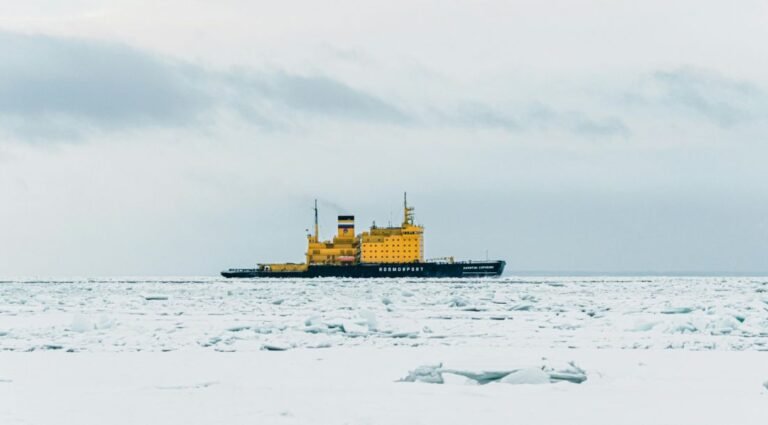The Impact of European Shipping on Arctic Climate: A Closer Look
The climate impact of European shipping in the Arctic region may be far larger than once believed due to past assessments focusing solely on EU-flagged vessels, a new study has found.
According to a study titled “Black carbon and CO2 emissions from EU-regulated shipping in the Arctic” by the International Council on Clean Transportation (ICCT), black carbon (BC) emissions in the region have nearly doubled between 2015 and 2021, with a ‘substantial’ share coming from ships traveling to and from EU ports.
The study has found that EU-regulated units of at least 5,000 GT emitted 52 tonnes of black carbon, accounting for 23% of total emissions. As disclosed, this is nearly twice the 27 tonnes emitted by EU-flagged ships. In the IMO Arctic, the ICCT revealed that 278 of the 564 ships of 5,000 GT or more reported to the EU MRV (49%), while only 112 flew an EU flag (20%).
In the broader Geographic Arctic, EU-regulated vessels reportedly emitted 317 tonnes of BC and 1.9 million tonnes of CO2, representing 44% and 60% of emissions from units of the same size. By comparison, EU-flagged vessels contributed just 145 tonnes of BC and 726,000 tonnes of CO2, or 20% and 23% of the emissions, respectively, the ICCT warned.
What is more, the analysis has underscored that, in 2021, Norway-flagged vessels burned the most fuel by mass in the Geographic Arctic, while Russia-flagged ships burned the most in the IMO Arctic.
The European Union has committed to addressing these emissions as part of its wider climate strategy related to the Arctic. To date, however, the contribution of EU shipping to emissions in this area has been primarily assessed based on the available information of vessels flying European flags, the ICCT stressed.
The total number of units navigating the region to and from European ports is ‘significantly’ higher. The study has noted that this has led to a scenario where the overall environmental impact is ‘severely’ downplayed.
“Our findings show that ships connected to EU trade, regardless of their flag, are major drivers of black carbon pollution in the Arctic. Recognizing these emissions in future policies could help the EU better align its climate goals with its real footprint in the Arctic,” Liudmila Osipova, ICCT Senior Researcher and lead author of the study, shared.
In order to tackle these challenges, the International Council on Clean Transportation has recommended the following measures:
- Accounting for BC emissions in the EU MRV database. This could provide a more comprehensive assessment of the European Union’s role in shipping-related BC emissions, the report states, both globally and in the Arctic;
- Recognizing BC as a significant climate pollutant. This would support the EU’s efforts to mitigate its climate footprint in the Arctic and help inform policy measures, such as future revisions of the EU Emissions Trading System and FuelEU Maritime;
- Replacing residual fuel with distillate. This could reduce BC emissions by 50%–80%, depending on engine type and operating conditions.
Regarding the third recommendation, the ICCT explained that EU-regulated units (5,000 GT) could cut black carbon emissions by 115-183 tonnes. Installing diesel particulate filters could further increase emission reduction to 206 tonnes.
Black carbon, usually released because of incomplete combustion in marine engines, has a 100-year global warming potential nine hundred times greater than that of carbon dioxide (CO2). Its effects are amplified in the Arctic due to the albedo effect, which refers to the ability of a surface to reflect sunlight.
The albedo effect plays an important role in determining the Earth’s temperature and climate. Surfaces with higher albedo reflect more sunlight, which contributes to cooling, while those with lower albedo absorb more sunlight and, thus, lead to warming.
Further exacerbating the scenario in the Arctic are the BC emissions from ships, which contribute to more warming and environmental degradation, compounding the challenge faced by an already vulnerable area of the world. In fact, black carbon has been described as a “key driver” of the rapid loss of Arctic Sea ice, with temperatures now rising 3-4 times faster than the global average.
Regulatory bodies and relevant governments have long been urged to tackle this matter. In December 2023, for instance, Clean Arctic Alliance and its member organization, Norway-based Bellona, called on the Arctic Council to take proactive steps in slashing black carbon emissions from maritime transportation.
The alliance also urged the International Maritime Organization (IMO) to devote more time to crafting measures and regulations that could minimize these environmental effects. The IMO did introduce a guidance in February last year. However, many industry stakeholders have described them as “not sufficient enough.”

